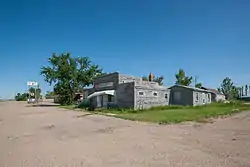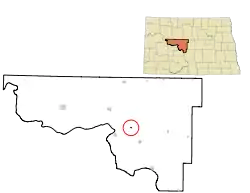Coleharbor, North Dakota
Coleharbor is a city in McLean County, North Dakota, United States. The population was 79 at the 2010 census.[5] Coleharbor was founded in 1904.
Coleharbor, North Dakota | |
|---|---|
 The former 83 Cafe in Coleharbor (now gone) | |
 Location of Coleharbor, North Dakota | |
| Coordinates: 47°32′33″N 101°13′23″W | |
| Country | United States |
| State | North Dakota |
| County | McLean |
| Area | |
| • Total | 0.18 sq mi (0.47 km2) |
| • Land | 0.18 sq mi (0.47 km2) |
| • Water | 0.00 sq mi (0.00 km2) |
| Elevation | 1,906 ft (581 m) |
| Population | |
| • Total | 79 |
| • Estimate (2019)[3] | 82 |
| • Density | 450.55/sq mi (173.56/km2) |
| Time zone | UTC-6 (Central (CST)) |
| • Summer (DST) | UTC-5 (CDT) |
| ZIP code | 58531 |
| Area code(s) | 701 |
| FIPS code | 38-15140 |
| GNIS feature ID | 1028419[4] |
History
Coleharbor was laid out in 1904 when the railroad was extended to that point.[6] The name combines that of a Soo Railroad official (W. A. Cole) and a reference to an older site on the Missouri River a few miles to the southwest (Coal Harbor).[7] In July 2006, three storms converged above the town, unleashing a derecho that resulted in significant damage around town, even blowing down part of the former school building (made of brick), while leaving the nearby grain elevator intact.[8]
Geography
Coleharbor is located at 47°32′33″N 101°13′23″W (47.542416, -101.223145).[9]
According to the United States Census Bureau, the city has a total area of 0.19 square miles (0.49 km2), all land.[10]
Demographics
| Historical population | |||
|---|---|---|---|
| Census | Pop. | %± | |
| 1950 | 315 | — | |
| 1960 | 210 | −33.3% | |
| 1970 | 112 | −46.7% | |
| 1980 | 150 | 33.9% | |
| 1990 | 88 | −41.3% | |
| 2000 | 106 | 20.5% | |
| 2010 | 79 | −25.5% | |
| 2019 (est.) | 82 | [3] | 3.8% |
| U.S. Decennial Census[11] 2018 Estimate[12] | |||
2010 census
As of the census[2] of 2010, there were 79 people, 37 households, and 22 families residing in the city. The population density was 415.8 inhabitants per square mile (160.5/km2). There were 51 housing units at an average density of 268.4 per square mile (103.6/km2). The racial makeup of the city was 96.2% White, 2.5% from other races, and 1.3% from two or more races. Hispanic or Latino of any race were 5.1% of the population.
There were 37 households, of which 27.0% had children under the age of 18 living with them, 51.4% were married couples living together, 8.1% had a female householder with no husband present, and 40.5% were non-families. 32.4% of all households were made up of individuals, and 8.1% had someone living alone who was 65 years of age or older. The average household size was 2.14 and the average family size was 2.77.
The median age in the city was 47.5 years. 20.3% of residents were under the age of 18; 3.8% were between the ages of 18 and 24; 20.3% were from 25 to 44; 35.4% were from 45 to 64; and 20.3% were 65 years of age or older. The gender makeup of the city was 55.7% male and 44.3% female.
2000 census
As of the census of 2000, there were 106 people, 42 households, and 30 families residing in the city. The population density was 581.2 people per square mile (227.4/km2). There were 56 housing units at an average density of 307.0 per square mile (120.1/km2). The racial makeup of the city was 98.11% White, 0.94% Native American, and 0.94% from two or more races.
There were 42 households, out of which 31.0% had children under the age of 18 living with them, 64.3% were married couples living together, 9.5% had a female householder with no husband present, and 26.2% were non-families. 21.4% of all households were made up of individuals, and 9.5% had someone living alone who was 65 years of age or older. The average household size was 2.52 and the average family size was 2.94.
In the city, the population was spread out, with 25.5% under the age of 18, 7.5% from 18 to 24, 24.5% from 25 to 44, 26.4% from 45 to 64, and 16.0% who were 65 years of age or older. The median age was 43 years. For every 100 females, there were 130.4 males. For every 100 females age 18 and over, there were 113.5 males.
The median income for a household in the city was $33,750, and the median income for a family was $40,313. Males had a median income of $27,000 versus $13,750 for females. The per capita income for the city was $13,845. There were 6.9% of families and 12.1% of the population living below the poverty line, including 15.4% of under eighteens and none of those over 64.
Climate
This climatic region is typified by large seasonal temperature differences, with warm to hot (and often humid) summers and cold (sometimes severely cold) winters. According to the Köppen Climate Classification system, Coleharbor has a humid continental climate, abbreviated "Dfb" on climate maps.[13]
References
- "2019 U.S. Gazetteer Files". United States Census Bureau. Retrieved July 27, 2020.
- "U.S. Census website". United States Census Bureau. Retrieved June 14, 2012.
- "Population and Housing Unit Estimates". United States Census Bureau. May 24, 2020. Retrieved May 27, 2020.
- "US Board on Geographic Names". United States Geological Survey. October 25, 2007. Retrieved January 31, 2008.
- "2010 Census Redistricting Data (Public Law 94-171) Summary File". American FactFinder. United States Census Bureau. Retrieved 2 May 2011.
- Gavett, Joseph L. (1 January 2007). North Dakota Immigrants: Coming to America. Watchmaker Publishing, Ltd. p. 44. ISBN 978-1-929148-74-5.
- http://www.webfamilytree.com/North_Dakota_Place_Names/C/coleharbor_(mclean_county).htm
- https://bismarcktribune.com/news/local/storm-shatters-tranquil-coleharbortown-determined-to-rebuild-from-devastating-wind/article_800187ec-f918-54ea-a802-18bce9a273d3.html
- "US Gazetteer files: 2010, 2000, and 1990". United States Census Bureau. February 12, 2011. Retrieved April 23, 2011.
- "US Gazetteer files 2010". United States Census Bureau. Archived from the original on July 2, 2012. Retrieved June 14, 2012.
- United States Census Bureau. "Census of Population and Housing". Retrieved July 19, 2013.
- "Population Estimates". United States Census Bureau. Retrieved September 21, 2019.
- Climate Summary for Coleharbor, North Dakota
